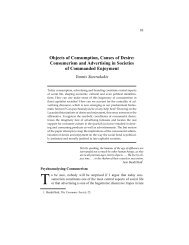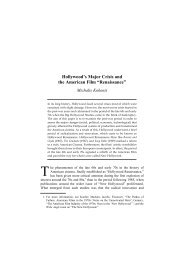19 International Symposium on Theoretical and Applied Linguistics ...
19 International Symposium on Theoretical and Applied Linguistics ...
19 International Symposium on Theoretical and Applied Linguistics ...
You also want an ePaper? Increase the reach of your titles
YUMPU automatically turns print PDFs into web optimized ePapers that Google loves.
G E N E R A L S E S S I O N<br />
percepti<strong>on</strong>s <strong>and</strong> attitudes in relati<strong>on</strong> to the exam itself, their teaching situati<strong>on</strong>s <strong>and</strong> classroom<br />
practices. The paper will report findings that show that the relati<strong>on</strong>ship is not a str<strong>on</strong>g <strong>on</strong>e <strong>and</strong> what<br />
exam designers expected did not actually take place in the classroom. During the presentati<strong>on</strong>,<br />
detailed reference will be made to the innovative research data collecti<strong>on</strong> process that was employed<br />
to investigate this relati<strong>on</strong>ship in the present educati<strong>on</strong>al c<strong>on</strong>text. Finally, the paper will identify areas<br />
in which the exam has the str<strong>on</strong>gest impact <strong>on</strong> <strong>and</strong> the outside factors that intervene in the process. It<br />
will c<strong>on</strong>clude by making recommendati<strong>on</strong>s to exam designers <strong>and</strong> teachers who are preparing for<br />
high-stakes language exams.<br />
Τhe acquisiti<strong>on</strong> of pers<strong>on</strong> case c<strong>on</strong>straint <strong>on</strong> Greek<br />
1 Vina Tsakali & 2 Kenneth Wexler<br />
1 University of Crete/University of Ioannina & 2 Massachusetts Institute of Technology<br />
1 tsakali@phl.uoc.gr & 2 wexler@mit.edu<br />
This study investigates the developmental properties of Pers<strong>on</strong> Case C<strong>on</strong>straint (PCC). The PCC<br />
affects combinati<strong>on</strong>s of weak (clitics, weak pr<strong>on</strong>ouns, agreement markers) direct <strong>and</strong> indirect objects<br />
prohibiting 1 st or 2 nd pers<strong>on</strong> direct objects in the presence of an indirect 3 rd pers<strong>on</strong> object (Perlmutter<br />
<str<strong>on</strong>g>19</str<strong>on</strong>g>71, Kayne <str<strong>on</strong>g>19</str<strong>on</strong>g>75, B<strong>on</strong>et <str<strong>on</strong>g>19</str<strong>on</strong>g>91, Adger <strong>and</strong> Harbour 2003, Anagnostopoulou 2003, 2005 am<strong>on</strong>g<br />
others). More recent research of pr<strong>on</strong>ominal elements has revealed that the restricti<strong>on</strong>s <strong>on</strong> the<br />
clusters of ph<strong>on</strong>ologically weak direct-indirect object come in two versi<strong>on</strong>s, i.e. the weak versi<strong>on</strong> <strong>and</strong><br />
the str<strong>on</strong>g versi<strong>on</strong>. The str<strong>on</strong>g versi<strong>on</strong> of the PCC prevents 1 st <strong>and</strong> 2 nd pers<strong>on</strong> direct objects from cooccuring<br />
with indirect objects of any pers<strong>on</strong>, that is 1 st , 2 nd or 3 rd (1)-(2), while the weak versi<strong>on</strong> of PCC<br />
allows combinati<strong>on</strong>s of 1 st <strong>and</strong> 2 nd indirect <strong>and</strong> direct objects in the absence of 3 rd pers<strong>on</strong> in the<br />
cluster.<br />
(1) Su/mu t<strong>on</strong> sinestise<br />
CL-GEN.2SG/ CL-GEN.1SG CL-ACC.3SG introduce-PST.3SG<br />
“She introduced him to you/to me”<br />
(2) *Tu/Su/Mu me/se sinestise<br />
CL-GEN.3SG/CL-GEN.2SG/CL-GEN.1SG CL-ACC.1SG/CL-ACC.2SG introduce-PST.3SG<br />
“She introduced me/you to him/to you/to me”<br />
Greek has been claimed to be a language that exhibits <strong>on</strong>ly the str<strong>on</strong>g versi<strong>on</strong> of PCC<br />
(Anagnostopoulou 2005). However there are some very specific instances where clitics clusters of<br />
direct-indirect objects seem to escape the c<strong>on</strong>straint as in (3). These are instances of Imperatives<br />
where the clitics follow the verb <strong>and</strong> the order of the clitics is not fixed as with Indicatives ((1)-(2)).<br />
Example (3) has two readings: it can either mean ‘send them to us’ or ‘send us to them’. Note that in<br />
(3) both clitics can be either genitive or accusative due to Case syncretism.<br />
(3) Stile mas tus<br />
(a) send-IMPER.2SG CL-GEN.1PL CL-ACC.3PL<br />
(b) send-IMPER.2SG CL-ACC.1PL CL-GEN.3PL<br />
“Send them to us”/ “Send us to them”<br />
However (3) becomes unambiguous in the reverse order of the clitics as in (4).<br />
(4) Stile tus mas<br />
send-IMPER.2SG CL-ACC.3PL CL-GEN.1PL<br />
“Send them to us”<br />
The present study aimed to test children’s knowledge of PCC <strong>on</strong> Greek. The experimental data<br />
obtained via grammaticality judgment tests <strong>on</strong> 17 different c<strong>on</strong>diti<strong>on</strong>s (including instances of<br />
indicatives, imperatives <strong>and</strong> ambiguous structures as in (3)). The data come from two groups of<br />
typically developed children. The first group c<strong>on</strong>sisted of <str<strong>on</strong>g>19</str<strong>on</strong>g> children (ages 4;2-4;10), <strong>and</strong> the sec<strong>on</strong>d<br />
group was c<strong>on</strong>sisted of 23 children (ages 5;1-5;9). The experimental data show that children of both<br />
groups have adult like performance <strong>on</strong> instances of indicatives, while they exhibited chance<br />
performance <strong>on</strong> structures like (3). Moreover there seem to be a developmental maturati<strong>on</strong> as<br />
younger children of first group perform worse (20%) <strong>on</strong> some instances of imperative.<br />
We argue that developmental data support syntactic <strong>and</strong> not morphological analyses of PCC.<br />
Following Anagnostopoulou 2005, we assume that the c<strong>on</strong>straint arises when two objects enter a<br />
feature checking relati<strong>on</strong> with <strong>on</strong>e <strong>and</strong> the same functi<strong>on</strong>al head, namely transitive v. In these<br />
c<strong>on</strong>figurati<strong>on</strong>s, high indirect objects move to transitive v first, followed by movement of direct objects.<br />
Thus, indirect objects check pers<strong>on</strong> <strong>on</strong> transitive v, <strong>and</strong> direct objects can <strong>on</strong>ly check the remaining<br />
number features of v resulting in a pers<strong>on</strong> restricti<strong>on</strong>.<br />
<str<strong>on</strong>g>19</str<strong>on</strong>g> th ISTAL 56






